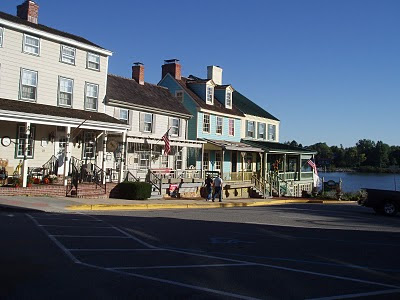Depart Essington 9:30 AM Friday 17, single hand, with breeze building 10 to 15 gusts to 20 out of the northwest.
2nd reef main sail with the ebb tide to Reedy Point at 2:00PM.
25nm starboard tack all the way, top speed 6.5knots, average SOG 5.5knots.
Enter Chesapeake and Delaware Canal to early for flood in the canal and motor against the tide at 2 to 3 knots until Summit and get assistance from the flood tide speeds up to 5 knots.
Arrive Chesapeake City after 6:00 PM and secure to the town dock. Rick saved a space for me on the town dock.
Meet up with Rick and Lori on "SV Take Five" who had been about 1/2 nm behind me most of the way, but with a stronger motor was through the canal in half my time, Wayne and Sally on "SV Virgina Dare" and Jack on SV Dionysus sister ship to Virginia Dare.
Saturday strolling around Chesapeake City and meet up with other sailors.
Depart Chesapeake City 6:00 AM on the ebb tide through the canal and stop at Delaware City just up river from the Delaware entrance at 8:30 AM for fuel, antisipating a hard motor against an ebb tide to Essington.
Talk with folks at the Delaware City Marina and depart at 9:30 AM, round Pea Patch Island and into the main channel by 10:00 AM.
Motor up river at 5 knot until the Delaware Memorial Bridge at Wilmington then a harder push against the tide and no assist from still air. Speed over ground (SOG) drops to 3 knot then to 2.5 knot at Marcus Hook and chop builds. Short period disorded chop 2 foot crest and 6 foot period persists all the way to Darby Creek, but a breeze starts to build of the NJ side and I get some assist on the 2nd reef main that I had previously set to dampen the normal 2 foot 40 foot period swell and 6 foot barge wake.
Arrive at Essington 4:00 PM Sunday 18, average SOG 4 knot.
Commadore Barry Bridge with tug Tow
Delaware Memorial Bridge
1st bridge at C&D entrance
One of many barges on the C&D
Railway lift bridge at Summit
Arrive Chesapeake City Bridge at sunset
Chesapeake City Town Dock
Chesapeake City
Chesapeake City Anchorage Basin (Engineers Cove)
Chesapeake City from the Bridge
Sunrise on the C&D, Chesapeake City departure
Delaware City on the old C&D
Leaving Delaware City, view downriver to the Salem cooling tower
Fort Delaware on Pea Patch Island
Catamaran sailor (shipping pallet, 2 hulls)
Off cherry Island Flats approaching Marcus Hook in opposing current















